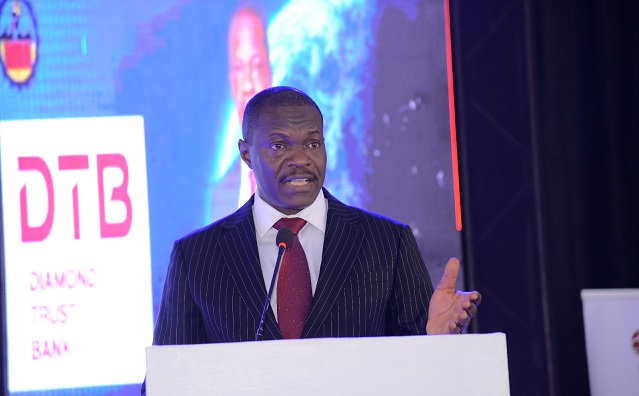
Kampala, Uganda | THE INDEPENDENT | Diamond Trust Bank’s Chief Executive Officer, Godfrey Ssebaana, has issued a clarion call for a paradigm shift in how Uganda finances its manufacturing sector. Speaking at the Second Annual Uganda Manufacturers’ Association (UMA) Financial Symposium and Exhibition held in Kampala on June 10, Ssebaana passionately argued that if Uganda is to unlock its full industrial potential, it must fundamentally rethink the financial architecture supporting its manufacturers.
He emphasized that manufacturing is not just one sector among many, but the “backbone of national transformation,” which is a vital driver of inclusive job creation, value addition, and enhanced export competitiveness.
“Uganda’s industrial sector holds the promise to transition us from a raw-materials-based economy to one grounded in productivity, innovation, and resilience. But this transformation will not happen unless we address the deep-rooted financing challenge,” Ssebaana emphasized.
He identified limited access to affordable credit, a chronic shortage of long-term capital, and a lack of customized financial products as the primary barriers holding the sector back. These systemic issues, he noted, continue to stifle the ambitions of many manufacturers, especially small and medium enterprises that are the lifeblood of Uganda’s economy.
He challenged both the public and private sectors to use this moment as a turning point, a chance to implement strategic financial reforms and build robust public-private partnerships capable of bridging the manufacturing financing gap. Only through coordinated efforts, he argued, can Uganda cultivate a financial ecosystem that rewards innovation, supports sustainability, and drives the industrial growth necessary for long-term national prosperity.
Highlighting the urgent need for bold financial innovation, Ssebaana outlined three strategic priority areas that could transform Uganda’s manufacturing landscape. First, he championed Blended Finance and Patient Capital, advocating for hybrid financing models that combine concessional funding with private sector investment. These models, he noted, are essential to de-risk high-impact projects in green manufacturing, agro-processing, and light engineering- sectors that are pivotal for driving sustainable industrial growth.
Ssebaana called for enhanced capacity and capital for institutions such as the Uganda Development Bank (UDB), Uganda Development Corporation (UDC), and the Agricultural Credit Facility, urging them to offer long-term, accessible financing solutions tailored to the unique needs of manufacturers.
Secondly, he placed emphasis on Green Finance, stressing that Uganda must align with global market shifts toward carbon neutrality. He encouraged manufacturers to adopt forward- looking tools like green bonds, climate insurance, and sustainability-linked loans to finance investments in clean energy, water conservation, and environmentally friendly technologies.
Thirdly, Ssebaana spotlighted the game-changing potential of Fintech solutions, particularly in bridging the financing gap for small and medium-sized enterprises (SMEs). Digital finance platforms, he noted, can revolutionize supply chain financing and mobile lending, but only if supported by progressive, enabling regulation.
“Collectively, these innovations represent the foundation of a financial system that not only funds growth but also fosters resilience, inclusivity, and sustainability in Uganda’s industrial sector,” he argued.
He also emphasized that financial innovation must be underpinned by robust policy reform and institutional support, stressing that without a conducive regulatory environment, even the most innovative financial tools will fail to achieve their intended impact. To this end, he proposed a comprehensive set of policy interventions, including tax incentives for manufacturers investing in energy-efficient and green technologies, and the development of public-private financing models to support the growth of industrial parks and logistics hubs.
Ssebaana also recommended the expansion of credit guarantee schemes to ease access to financing for SMEs, along with efforts to deepen Uganda’s capital markets to facilitate long- term funding through bonds, equity instruments, and asset-backed securities. He challenged government bodies, regulators, and financial institutions to move decisively from diagnosing the country’s industrial finance challenges to implementing real, results-driven solutions.
David Bahati, Minister of State for Industry, acknowledged the urgency of reform and pledged government support in addressing manufacturers’ concerns.
“Manufacturers walk into your banking halls and wait weeks for a loan decision. This is unacceptable,” Hon. Bahati said, challenging banks to reduce bureaucracy and adopt business vision-based lending, not just asset-backed lending.
Drawing inspiration from global best practices, he encouraged financial institutions to look beyond collateral and consider the vision and innovation behind businesses—citing examples from tech giants who started without assets but with great ideas.
The Minister noted that Uganda’s economy is projected to hit USD 60.4 billion in GDP by the end of June, growing at 6.3% annually, positioning it as the 7th fastest-growing economy in the world. He credited much of this success to the private sector, especially manufacturers, who now contribute about 35% to national revenue and 17% to GDP.
 The Independent Uganda: You get the Truth we Pay the Price
The Independent Uganda: You get the Truth we Pay the Price



